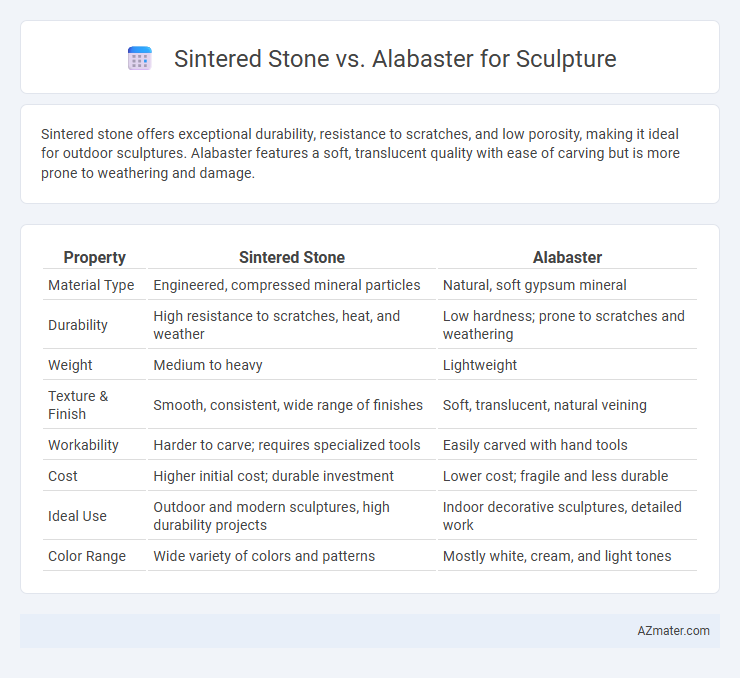Sintered stone offers exceptional durability, resistance to scratches, and low porosity, making it ideal for outdoor sculptures. Alabaster features a soft, translucent quality with ease of carving but is more prone to weathering and damage.
Table of Comparison
| Property | Sintered Stone | Alabaster |
|---|---|---|
| Material Type | Engineered, compressed mineral particles | Natural, soft gypsum mineral |
| Durability | High resistance to scratches, heat, and weather | Low hardness; prone to scratches and weathering |
| Weight | Medium to heavy | Lightweight |
| Texture & Finish | Smooth, consistent, wide range of finishes | Soft, translucent, natural veining |
| Workability | Harder to carve; requires specialized tools | Easily carved with hand tools |
| Cost | Higher initial cost; durable investment | Lower cost; fragile and less durable |
| Ideal Use | Outdoor and modern sculptures, high durability projects | Indoor decorative sculptures, detailed work |
| Color Range | Wide variety of colors and patterns | Mostly white, cream, and light tones |
Introduction: Choosing the Right Material for Sculpture
Sintered stone offers exceptional durability, resistance to weathering, and a wide range of textures, making it ideal for outdoor and high-traffic sculptures. Alabaster, prized for its translucent quality and smooth carving properties, allows for intricate details and a soft, luminous finish best suited for indoor display. Selecting between sintered stone and alabaster depends on the desired durability, aesthetic qualities, and environmental conditions of the sculpture's placement.
What is Sintered Stone? Key Features Explained
Sintered stone is an engineered material created by compacting natural minerals under extreme heat and pressure, resulting in a durable, non-porous surface ideal for sculptures requiring high resistance to scratches, stains, and weathering. Key features of sintered stone include its homogeneity, low water absorption rate, UV resistance, and a wide range of colors and finishes, making it suitable for both indoor and outdoor artistic applications. Compared to alabaster, which is softer and more translucent, sintered stone offers enhanced structural integrity and longevity for sculptures exposed to varying environmental conditions.
Understanding Alabaster: Properties and History
Alabaster, a fine-grained, translucent form of gypsum or calcite, is prized for its softness and workability, making it ideal for detailed sculptural work. Historically, alabaster has been used since ancient times in Egyptian, Mesopotamian, and Renaissance art, valued for its smooth texture and ability to hold intricate carvings. Compared to sintered stone, alabaster's natural warmth and delicate veining offer a more organic aesthetic, though it is less durable and more susceptible to moisture damage.
Durability: Sintered Stone vs Alabaster
Sintered stone exhibits superior durability compared to alabaster, boasting high resistance to scratches, stains, and weathering due to its engineered, compact structure. Alabaster, a softer and more porous material, is prone to chipping, scratching, and damage from moisture or acid exposure, making it less suitable for outdoor or high-traffic sculptures. The longevity and strength of sintered stone make it ideal for sculpture applications requiring robust material performance and minimal maintenance.
Workability and Artistic Flexibility
Sintered stone offers superior workability for sculptors due to its durability and resistance to weathering, allowing for intricate detailing and long-lasting outdoor installations. Alabaster provides unparalleled artistic flexibility with its softness and translucency, enabling fine carving and dramatic light effects but requiring careful handling due to its fragility. Choosing between sintered stone and alabaster depends on the desired balance between durability, detail precision, and the visual impact of the sculpture.
Aesthetic Appeal and Visual Differences
Sintered stone offers a sleek, modern aesthetic with a consistent texture and rich color palette that enhances contemporary sculptures. Alabaster, known for its translucent quality, provides a soft, glowing effect that emphasizes delicate details and natural veining. The visual contrast lies in sintered stone's durability and uniformity compared to alabaster's ethereal appearance and vulnerability to light transmission.
Maintenance and Care Requirements
Sintered stone requires minimal maintenance due to its non-porous surface, resisting stains, scratches, and UV damage, making it ideal for outdoor and high-traffic sculptures. In contrast, alabaster, being a softer, porous material, demands careful handling, frequent dusting, and protection from moisture and acidic substances to prevent discoloration and surface degradation. Proper care for alabaster typically involves gentle cleaning with a soft cloth and using sealants to enhance durability, whereas sintered stone allows for easy cleaning with mild soap and water.
Cost Comparison: Sintered Stone vs Alabaster
Sintered stone typically costs between $50 to $100 per square foot, offering a durable and low-maintenance option for sculptures, whereas alabaster ranges from $30 to $70 per square foot but requires careful handling due to its softness. The initial investment for sintered stone is higher, yet it provides better longevity and resistance to weathering, reducing long-term maintenance expenses. Alabaster's lower upfront cost makes it appealing for indoor sculptures, but increased vulnerability often leads to higher restoration costs over time.
Environmental Impact and Sustainability
Sintered stone offers superior environmental benefits over alabaster due to its durability and use of natural minerals with minimal additives, reducing waste and extending lifecycle in sculptures. Alabaster, being a softer gypsum-based stone, often requires more frequent replacements or restorations, increasing material consumption and environmental footprint. The sustainable sourcing and recyclability of sintered stone make it a more eco-friendly choice for long-lasting sculptural art.
Which Material is Better for Sculpture? Expert Insights
Sintered stone offers superior durability, weather resistance, and a wide range of colors and finishes, making it ideal for both indoor and outdoor sculptures. Alabaster, prized for its translucent beauty and ease of carving, is better suited for detailed, delicate indoor sculptures but is vulnerable to scratches and moisture damage. Expert sculptors recommend sintered stone for long-lasting, maintenance-free artworks, while alabaster is favored for intricate, expressive pieces where light interaction is essential.

Infographic: Sintered stone vs Alabaster for Sculpture
 azmater.com
azmater.com